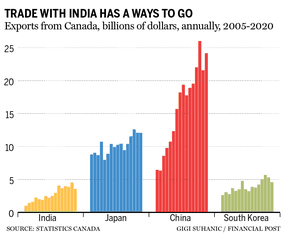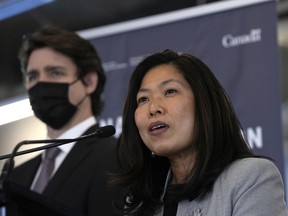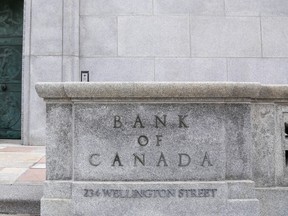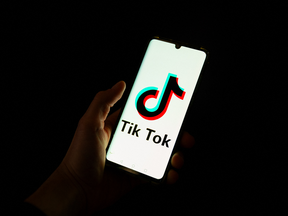Ng’s visit suggests that both India and Canada are ready to move on from whatever problems that trip created
Article content
Trade Minister Mary Ng will be heading to India this week, marking what would be the first high-level visit to Asia’s third-biggest economy since Prime Minister Justin Trudeau’s ill-fated tour of the country in 2018.
Advertisement
This advertisement has not loaded yet, but your article continues below.
Article content
Ng announced the visit in a press release on March 7. The statement excludes dates, but a spokesperson said Ng was planning to leave by mid-week. Her program in India was set to include a meeting with Piyush Goyal, minister of commerce and industry, and a ministerial conference to discuss trade and investment.
“Canada and India already share strong trade and people-to-people ties, and I am committed to further strengthening our bilateral commercial relations,” Ng said in a statement.
India was an early focus of Trudeau’s trade policy after he was elected in 2015, as he looked for ways to lessen Canada’s dependence on the United States. That push was derailed by the 2018 trip, which generated so many negative headlines that it became a political issue back home. Among the issues: Indian Prime Minster Narendra Modi didn’t bother to greet Trudeau when he arrived; Jaspal Atwal, convicted for attempting to assassinate an Indian cabinet minister in 1986, was invited to a party that Trudeau hosted for Indian dignitaries; and the prime minister was mocked for repeated “costume” changes.
Advertisement
This advertisement has not loaded yet, but your article continues below.
Article content

There were positive headlines, too, but those largely have been forgotten. Ng’s visit suggests that both India and Canada are ready to move on from whatever problems that trip created. India is gaining more economic influence in the region, as its population is set to overtake China’s within a decade. The country’s strategic importance is also rising, as the United States and its allies look for counterweights to China’s outsized influence over the region.
Canada’s trade department has held several “stocktaking meetings” since 2018, as officials continued to probe for ways to complete a trade agreement between the two countries. In his most recent mandate letter to Ng, Trudeau said he wants the minister to continue negotiating bilateral and regional trade agreements in Asia, home to a disproportionate number of the world’s fastest growing economies.
Advertisement
This advertisement has not loaded yet, but your article continues below.
Article content
Rohinton Medhora, president of the Centre for International Governance Innovation, a think-tank, said Ng could struggle to make progress because the federal government still hasn’t come up with a comprehensive Indo-Pacific strategy.
“In the most recent Indian federal budget are plans to increase spending on infrastructure by about one-third,” Medhora said. “So there’s a real opportunity, at least for Canadian businesses, to get in on some of that development activity.”
-

Russia warns of $300 oil, Nord Stream 2 closure if West bans energy imports: live Ukraine updates
-

Mrs. Dunster’s dilemma: Volatile wheat market is putting the squeeze on bakers
-

Canada inspires other nations to consider tariffs on Russian trade
Advertisement
This advertisement has not loaded yet, but your article continues below.
Article content
In November, Ng’s office announced that she started trade talks with the Association of Southeast Asian Nations (ASEAN), an economic bloc that comprises 10 countries including Thailand, Vietnam, the Philippines and Singapore. This was months after she announced the kick-off of discussions in June with Indonesia, who is also an ASEAN member, to draw up a free-trade agreement.
Canada already has agreements with some ASEAN countries either through bilateral deals or the Trans Pacific Partnership. An agreement with Canada’s 11th-largest export market and 12th largest trading partner overall would improve the $16-million trade deficit between the two countries and carve out a deal with an economic powerhouse in Asia. It would be the next best get after China, a relationship that appears destined to be icy for the foreseeable future, following the souring of relations after the arrest of Michael Kovrig and Michael Spavor by China in apparent retaliation for the arrest of Huawei Technologies Co. Ltd. executive Meng Wanzhou in Canada.
India, which remains neutral on the Russian invasion of Ukraine, is a more approachable partner than China, which has sided with President Vladimir Putin, Medhora said.
“There’s lots of reasons to believe that India is not a lost cause or in the Russian camp and I think Mary Ng’s visit signals that Canada does not see India as having created enough issues on the Russian front to call off the meeting,” he said.
• Email: bbharti@postmedia.com | Twitter: biancabharti
Advertisement
This advertisement has not loaded yet, but your article continues below.
Trade minister Mary Ng to visit India, signaling shift in relations since Trudeau’s ill-fated 2018 trip
2022-03-07 22:40:20





